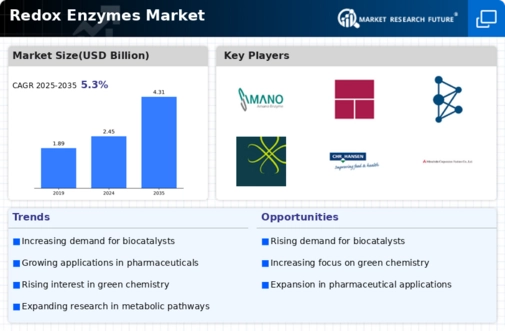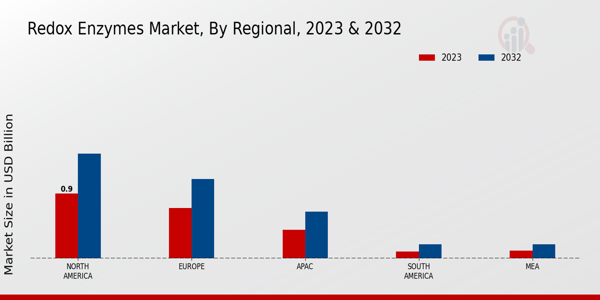Market Growth Projections
The Global Redox Enzymes Market Industry is projected to experience substantial growth over the coming years. With a market value anticipated to reach 2.45 USD Billion in 2024 and further expand to 4.31 USD Billion by 2035, the industry is poised for a robust trajectory. The compound annual growth rate of 5.26% from 2025 to 2035 indicates a strong demand for redox enzymes across various sectors. This growth is driven by factors such as increasing applications in biotechnology, agriculture, and healthcare, reflecting the versatile nature of redox enzymes in addressing contemporary challenges.
Advancements in Biotechnology
Technological advancements in biotechnology significantly influence the Global Redox Enzymes Market Industry. Innovations in enzyme engineering and production techniques enhance the efficiency and specificity of redox enzymes, making them more applicable in diverse industrial processes. For instance, the development of recombinant DNA technology allows for the production of enzymes with tailored properties, thereby expanding their utility. This trend is expected to contribute to the market's growth, with projections indicating a rise to 4.31 USD Billion by 2035. As industries increasingly adopt these advanced biotechnological solutions, the demand for redox enzymes is likely to surge, fostering a competitive landscape.
Growing Demand for Biocatalysts
The Global Redox Enzymes Market Industry experiences a notable increase in demand for biocatalysts across various sectors, including pharmaceuticals and food processing. Biocatalysts, which are often derived from redox enzymes, offer environmentally friendly alternatives to traditional chemical processes. This shift towards sustainable practices is driven by regulatory pressures and consumer preferences for greener products. As a result, the market is projected to reach 2.45 USD Billion in 2024, reflecting a robust growth trajectory. The adoption of redox enzymes in biocatalysis not only enhances reaction efficiency but also reduces waste, aligning with global sustainability goals.
Rising Awareness of Health Benefits
The Global Redox Enzymes Market Industry is witnessing a surge in consumer awareness regarding the health benefits associated with redox enzymes. These enzymes play a crucial role in various biological processes, including metabolism and antioxidant defense. As consumers become more health-conscious, there is a growing inclination towards dietary supplements and functional foods enriched with redox enzymes. This trend is supported by scientific research highlighting the potential health benefits, such as improved immune function and enhanced energy levels. Consequently, the market is poised for growth, as manufacturers increasingly incorporate these enzymes into their products to meet consumer demand.
Increasing Applications in Agriculture
The Global Redox Enzymes Market Industry is expanding due to the increasing applications of redox enzymes in agriculture. These enzymes are utilized in soil health management and crop protection, enhancing nutrient availability and promoting plant growth. The adoption of redox enzymes in agricultural practices aligns with the global push towards sustainable farming methods. As a result, the market is expected to experience a compound annual growth rate of 5.26% from 2025 to 2035. This growth is indicative of the agricultural sector's recognition of the benefits of enzymatic solutions in improving crop yields and reducing reliance on chemical fertilizers.
Regulatory Support for Green Technologies
Regulatory frameworks promoting green technologies significantly impact the Global Redox Enzymes Market Industry. Governments worldwide are implementing policies that encourage the use of environmentally friendly processes, including the adoption of redox enzymes in various applications. This regulatory support not only fosters innovation but also incentivizes industries to transition towards sustainable practices. As a result, the market is likely to benefit from increased investments in research and development, leading to the introduction of novel enzymatic solutions. The alignment of regulatory initiatives with market trends suggests a favorable environment for the growth of redox enzymes in the coming years.




















